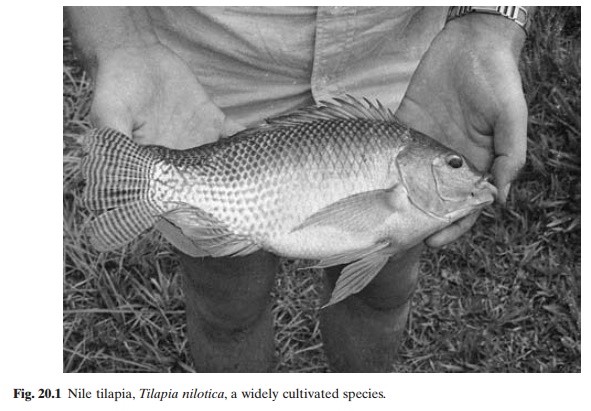Chapter: Aquaculture Principles and Practices: Tilapias
Cage and pen culture - Tilapias
Cage and pen culture
Coche (1982) made a very extensive review of cage culture attempts in
different countries. The early interest in cage culture of tilapia was on the
assumption that wild spawning would not occur in cages or, if it did, that the
progeny would not remain in the cages and cause over-population, as in ponds.
Later the value of cage culture in utilizing open bodies of water, particularly
those of eutrophic lakes, coastal areas and running waters, was recognized.
Though of widespread interest, most of the cage culture presently practised is
still on an experimental scale, with only a few exceptions as in some areas of
the Philippines, Ivory Coast, Costa Rica and El Salvador. The commonly used
species are T. mossambica, T. nilotica and T. aurea.
Cages are mainly used for grow-out, and the necessary fry or fingerlings
are produced in land-based facilities like ponds, cisterns, etc., or in hapas
installed in ponds.As described earlier, special double-walled cages can be
used for spawning of tilapia in open waters. Fixed and floating cages are used
in the open waters of lakes in the Philippines for tilapia grow-out. The fixed
cages are used in shallow eutrophic lakes and the floating cages in deep lakes.
The stocking density varies with the size of the cage, but in floating cages up
to 25 fingerlings/m2 of 3–4 cm length are common. Artificial feeding is generally not
practised, except in waters with low productivity. In six months, from February
to July, the fingerlings grow to a size of 200– 250 g each, and in the nine
months from August to April to 250–300 g each. The growth rate is largely based
on the primary productivity of the lake and the management practices, which
include the density of cages in the lake and the distance between cages.
The stocking rate of T. nilotica in fixed cages ranges from 15
to 50 fingerlings/m2, and the duration of culture from 4 to 12 months. The growth rate
depends on the productivity of the lake. Without supplemental feeding, 5cm
fingerlings stocked at 15 per m2 in Laguna de Bay attained 150–180 g in four months. The average
production of 3.5–7 kg/m3 of 100–150 g fish has in recent years been greatly reduced as a result
of crowding of cages in the lake (Coche, 1982).
Pen culture of tilapia appears to be practised only in the Philippines
in the Laguna de Bay. The same materials used for abandoned milk-fish pens are
used for the construction of tilapia pens, but smaller pens of 0.5–1 ha are
preferred. The pens are stocked at the rate of 20–50 fingerlings/m2 and fed with rice bran or wheat
bran at 2–3 per cent of body weight per day. The growth rate varies according
to the productivity of the lake, and in productive waters they can grow to a
size of 170–250 g in four to five months, even without feeding. One of the
major problems in pen culture of tilapia is the poor catchability of the
species used, namely T. nilotica. The harvesting rate with seine
and gillnets has been reported to be only about 15–30 per cent.

Related Topics